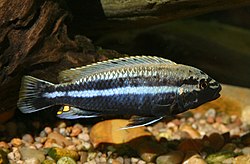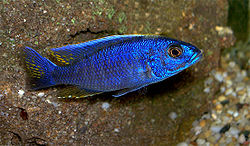| Haplochromis | |
|---|---|
 | |
| Haplochromis thereuterion | |
| Scientific classification | |
| Kingdom: | Animalia |
| Phylum: | Chordata |
| Class: | Actinopterygii |
| Order: | Cichliformes |
| Family: | Cichlidae |
| Subfamily: | Pseudocrenilabrinae |
| Genus: | Haplochromis Hilgendorf, 1888 |
| Type species | |
| Chromis obliquidens Hilgendorf, 1888 | |
| Synonyms | |
Many, see text | |
Haplochromis is a ray-finned fish genus in the family Cichlidae. It has been used as the default "wastebin taxon" for Pseudocrenilabrinae cichlids of the East African Rift, and as such became the "largest" fish "genus". Many of these cichlids are popular aquarium fishes; like similar Haplochromini they are known as "haplos", "happies" or "haps" among aquarium enthusiasts. [1]
Contents
- Extinction crisis in Lake Victoria
- Systematics and taxonomy
- Species
- Undescribed species
- Formerly in Haplochromis
- Synonyms of Haplochromis
- Footnotes
- References
The genus was established by F.M. Hilgendorf in 1888. It was originally conceived as a subgenus of A.C.L.G. Günther's "Chromis", at that time an even larger "wastebin genus" for Pseudocrenilabrinae cichlids. The type species of Hilgendorf was H. obliquidens . "Chromis" of Günther turned out to be a junior homonym of G. Cuvier's ocean fish genus Chromis , already established in 1814, and was abolished. As the years went by, other genera of (mostly) Haplochromini were lumped with and split again from Haplochromis, and the final delimitation of the clade around H. obliquidens is not yet done.


